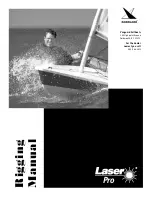
Cobalt_OM_preprint_shell.fm Page 1 Wednesday, March 1, 2006 5:39 AM
296 Owner’s Manual
2
-
15
R
ESPONSIBILITIES
AND
S
AFETY
Boating, alcohol and the use of other drugs just do
not mix. Mixing boating, alcohol and other drugs
results in many marine accidents and deaths.
These substances reduce your reaction time and
affect your better judgment. Combined with the sun,
wind, waves and noise of other watercraft, the
effects of drugs are increased and will significantly
reduce your reaction time. Do not operate your boat
under the influence of alcohol or other drugs. As
the owner/operator, you are responsible for the
alcohol/drug use and onboard behavior of your
passengers.
If the operator’s blood alcohol content is above the
state’s legal limit, violators are subject to a civil or
criminal penalty, imprisonment or both. Operating a
boat under the influence can also result in a loss of
automobile driving privileges.
Passengers
Whenever you are going for an outing, make sure
that at least one passenger is familiar with the
operation and safety aspects of the boat in case of
emergency. Show all passengers the location of
emergency equipment and explain how to use it.
Do not allow passengers to drag their feet or hands
in the water, or sit on the bow, deck, gunwale or
transom platform while engines are running.
Ventilation
Your Cobalt boat may be equipped with carbon
monoxide (CO) detector(s), if your boat is a cabin
type or built with an enclosed changing area.
A carbon monoxide (CO) detector will only detect
the presence of carbon monoxide gas at its sensor
and will not detect other vapors such as gasoline.
Carbon monoxide may be present in other areas.
Carbon monoxide poisoning should not be
confused with seasickness, intoxication or heat
stress. If someone complains of irritated eyes,
headache, nausea, weakness or dizziness, or you
suspect carbon monoxide poisoning, immediately
move the person to fresh air, investigate the cause
and take corrective action. Seek medical attention if
necessary.
KC-0153C
A
DANGER
Avoid the possibility of injury or death
from exposure to carbon monoxide
(CO). All gasoline and diesel engines
and fuel burning appliances such as
heaters, stoves and generators produce
CO. CO is a colorless, odorless and
dangerous gas. Direct and prolonged
exposure to CO will cause brain damage
or death. Signs of exposure to CO
include nausea, dizziness, drowsiness,
ears ringing, headaches,
unconsciousness and cherry red skin
color. Avoid exposing your passengers
or yourself to carbon monoxide. Test the
carbon monoxide detector operation
before each trip, at least once a week
and after the boat has been in storage.
DO NOT tamper with the operation of the
carbon monoxide detector. It is installed
for your safety.
Summary of Contents for 296 BOWRIDER
Page 6: ...vi 296 Owner s Manual COBAL T 296 BOWRIDER NOTES ...
Page 26: ...1 20 296 Owner s Manual COBAL T 296 BOWRIDER SECTION 1 NOTES ...
Page 96: ...3 42 296 Owner s Manual COBAL T 296 BOWRIDER SECTION 3 NOTES ...
Page 99: ...296 Owner s Manual 4 3 SYSTEMS FUEL ROUTING COB_0289_A FUEL FILL FUEL VENTS FUEL TANK ENGINE ...
Page 124: ...6 10 296 Owner s Manual COBAL T 296 BOWRIDER SECTION 6 NOTES ...
Page 132: ...7 8 296 Owner s Manual COBAL T 296 BOWRIDER SECTION 7 NOTES ...
















































